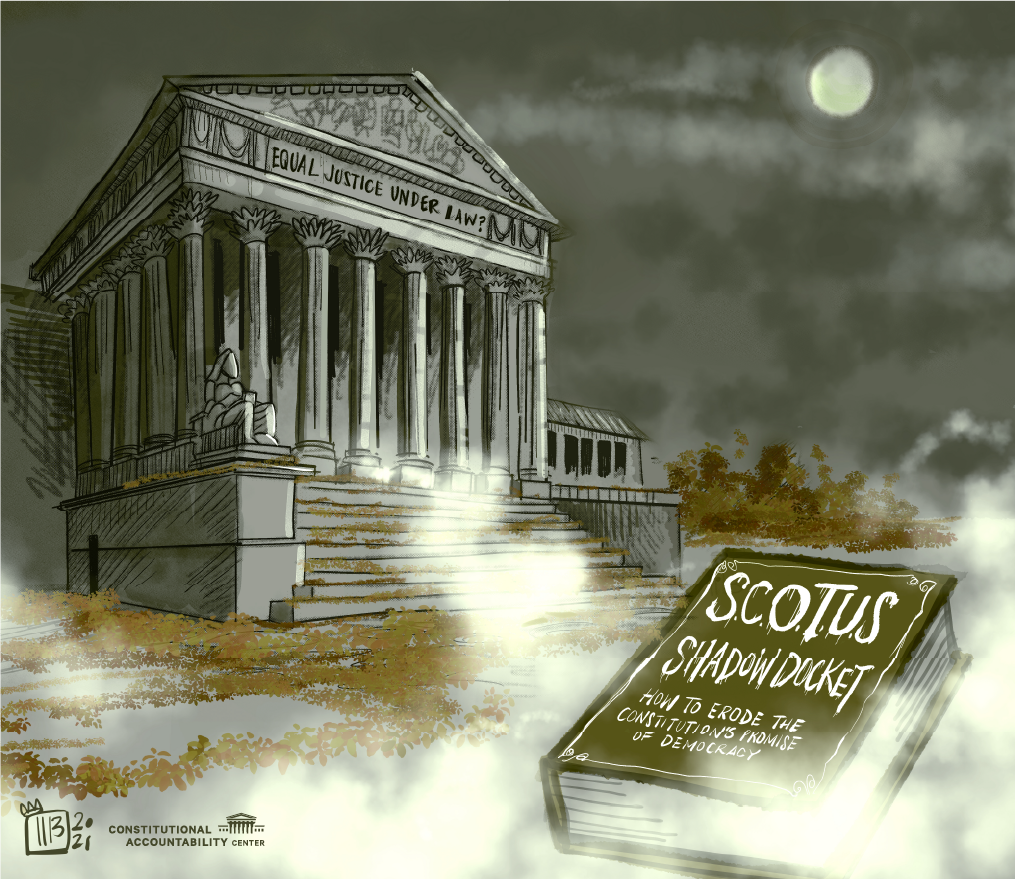The Shadow Docket and Police Accountability

The shadow docket strikes again. This time the Roberts Court has dispensed with its regular decision-making process to make it harder for persons victimized by police brutality to have their day in court.
Last week brought a fresh reminder that the Supreme Court’s shadow docket—its opinions and orders issued in a hasty manner without full briefing and oral argument—has become a tool for a Supreme Court dominated by conservatives to move the law sharply to the right without the transparency and sustained deliberative decision-making essential to the judicial process. Already this term, the Supreme Court has decided a string of incredibly important emergency applications through the shadow docket, most notably allowing Texas to temporarily nullify the protections of Roe v. Wade by banning abortions beginning at six weeks of pregnancy. Now, in a pair of unsigned rulings decided last week on a summary basis, the Justices have made it harder to hold police officers accountable for their misconduct, doubling down on the qualified immunity doctrine the Supreme Court invented decades ago to make it harder to sue police officers.
Usually, the Supreme Court first decides whether to hear an appeal and then devotes months to considering its decision, including by reading extensive briefs, hearing from a slew of interested parties, and holding oral argument to carefully consider the parties’ claims. But in Rivas-Villegas v. Cortesluna and City of Tahlequah v. Bond, the Supreme Court dispensed with this careful and deliberative process, deciding, in a summary fashion, that the police officers sued for inflicting excessive force were immune from being held accountable in a court of law under the doctrine of qualified immunity. Rather than give the pair of cases full consideration, the Justices acted through a truncated process, using the shadow docket to close the courthouse doors to those alleging police abuse of power.
This has become the norm in recent years. Many of the qualified immunity rulings decided by the Roberts Court have been summary reversals decided using the abbreviated shadow docket process. In ten separate cases, the Roberts Court has summarily reversed rulings denying qualified immunity, reaching out to decide cases that would not normally merit Supreme Court review. Rivas-Villegas and Bond are just the latest in a long line of cases where the Supreme Court has used its shadow docket to send a message to lower courts that it should be incredibly difficult to sue police officers for abusing their authority. These cases do not clarify the constitutional constraints on the police, but signal that lower courts should grant qualified immunity in all but the most exceptional of cases.
By deciding qualified immunity cases in summary rulings without full briefing, hearing from interested parties, and holding oral argument, the Court has been able to avoid fully and publicly grappling with qualified immunity’s fundamental flaws. The doctrine—made up by the Justices—erodes the protection of constitutional rights and has no basis in the text and history of the federal civil rights law, known as Section 1983, that that gives individuals the right to sue state and local officers for violating constitutional rights. That law provides no official immunities from suit: Congress made a conscious choice not to provide any official immunities because it did not want to place state officials above the law. But rather than face these fundamental questions about qualified immunity’s legal basis and legitimacy with transparency and reason, the Supreme Court continues to resort to the shadow docket to make it harder to hold police officers accountable when they violate bedrock rights.
Rather than abolish the doctrine of qualified immunity to ensure that individuals can redress brutal police violence—which is what the Supreme Court should be doing in accordance with the text and purpose of the underlying civil rights law—the shadow docket rulings in Rivas-Villegas and Bond amplify the worst aspects of qualified immunity. First, they make it virtually impossible to sue officers by insisting that police officers cannot be sued for violating constitutional rights unless the plaintiff can point to a prior precedent involving essentially identical facts. As the Court’s unsigned order in Rivas-Villegas insisted, to sue a police officer for violating constitutional rights, the individual “must identify a case” that demonstrated that the officer’s “specific conduct was unlawful.” Without a nearly identical case, the Court insisted, police officers cannot be held accountable. This incredibly high threshold means that much of the time, constitutional violations go unremedied and justice is denied to those victimized by abuse of power. Even more troubling, the Court even raised the possibility that binding circuit precedent might not be enough to overcome the defense of qualified immunity, which would mark a seismic expansion of the judge-made doctrine and make it even harder to hold officers accountable for abuse.
Second, by granting qualified immunity on the grounds that the law was not clearly established and refusing to decide whether the police transgressed the Constitution, the Supreme Court has effectively frozen the contours of constitutional safeguards in place, preventing rights from ever becoming clearly established in the first place. Rulings like Rivas-Villegas and Bond leave the law in a state of perpetual uncertainty, making it impossible to hold the police accountable in future cases. As a result, the cycle of state violence continues unchecked.
Americans expect a commitment to the hallmarks of deliberation, fairness, and transparency from their highest Court. But time and again, the Supreme Court seems to forsake these bedrock features of the judicial process to sanction the violation of fundamental rights.
